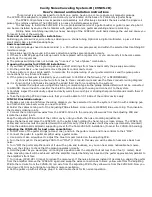
QuantAsylum QA401 User
’s
Manual
Page
8
LEDs
Link LED
This LED indicates the analyzer is connected to the PC and talking to the analyzer
application.
Run LED
This LED indicates the analyzer is currently running (acquiring) data.
Atten LED
This LED indicates the internal 20 dB attenuator is active. The attenuator is active when
the device is unpowered. However, try not to leave the QA401 connected to large
voltage swings while the device is unpowered. At higher voltages, it could damage the
unit.
BNC Inputs
There are two stereo inputs (Left and Right) and two stereo outputs (Left and Right). Each input and
output is differential. This means the magnitude of the + and
–
are signals are equal and opposite. For
example, if you were to look at the output signals on an oscilloscope, you’d see that when the L+ output
was sweeping a sine wave with a peak of +3V, the L- output would be sweeping a mirror image sine
wage with a peak at -3V. Differential signals are commonly used in noisy environments because
interfering signals that appear on both inputs simultaneously are “cancelled” and greatly attenuated
.
However, for much of your audio work, you may prefer to use the device in single ended mode
especially if you are working on line level consumer audio type equipment.
If you wish to use the inputs single ended, then you could use a BNC terminator on the L- input, and
treat the L+ input as a single ended input. If you do not use the input terminator, then you will see some
thermal noise from the unused input resistor, which will raise the overall noise floor.
Understanding Differential Measurements
Differential measurements can create confusion even among very experienced engineers. Some
examples will help highlight the differences.
If you set the generator to 0 dBV and connect an to an Input+ and ground the Input-, then the
measured input will be reported as 0 dBV.
With the output set to 0 dBV, each output will measure 1Vrms on a DVM relative to ground (BNC outer
conductor). A differential measurement on a DVM (from Out+ to Out-) will measure as 2Vrms. This is
because the Out+ and Out- are 180 degrees out of phase with each other.
If you set the output to 0 dBV and connect both the Out+ and Out- connectors to the In+ and In-
connectors, then the QA401 measurement will show a peak of 6 dBV. This is because you are driving the
inputs differentially.
This can be very confusing to first-time users: You are driving the inputs with 1Vrms
(0 dBV), and yet the QA401 is reporting 2Vrms (6 dBV). But this is precisely the same measurement
reported by the DVM when you placed the DVM across the outputs.
Keep in mind the QA401 inputs have no idea if you are driving a single input with 1Vrms and grounding
the other input OR if you are driving both inputs with 0.5Vrms. In both cases, you are hitting the ADC









































